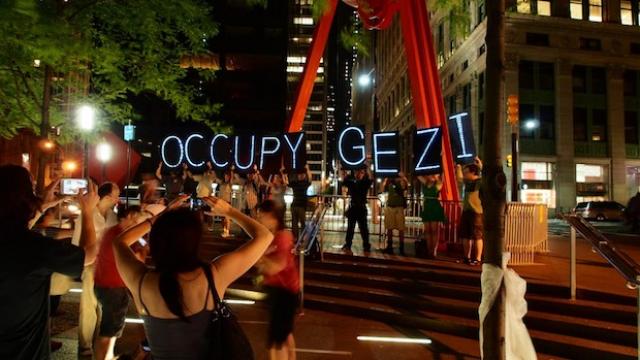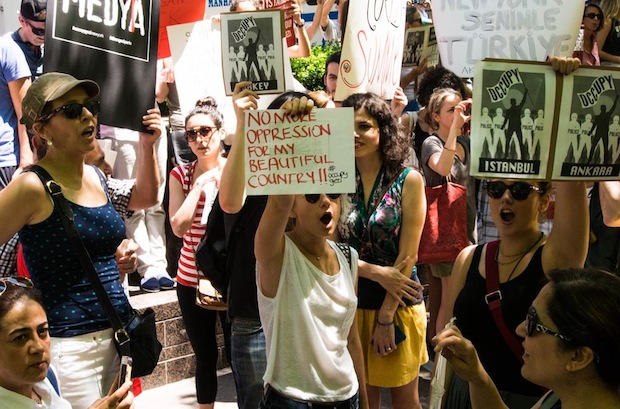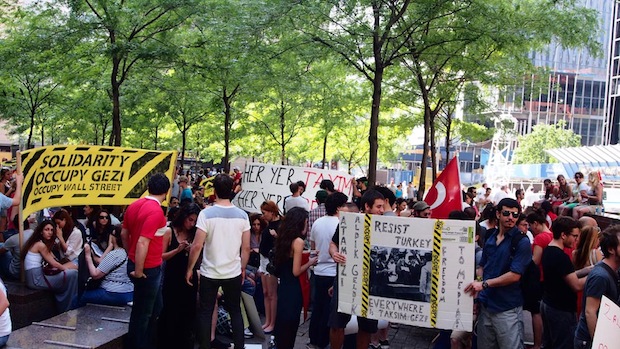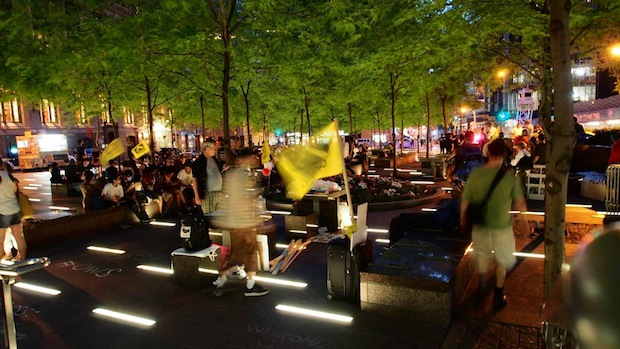
Gliding down Broadway last Saturday, the blazing-red Mark di Suvero sculpture known to arts professionals as “Joie de Vivre” and to Occupy Wall Street as “the Weird Red Thing” comes into view. The scene is familiar. Facing west, I see white-shirt cops on Broadway and Liberty and the Imperial Walker-esque NYPD surveillance tower perched in the lower right corner of the park. More friendly, are the falafel and juice stands lined up on the left. The 33,000 square feet of public/private space formerly known as Zuccotti Park pulses with energy: men and women waving red flags; shouting in unison and singing spirited songs in Turkish.
It is day one of #OccupyGeziParkNYC, an American offshoot of the Turkish #OccupyGeziPark, that began as peaceful sit-in demonstration against a shopping mall slated to replace Istanbul’s last major public square. The protest quickly morphed into a Tahrir-like movement to oust Prime Minister Tayyip Erdogan. Tens of thousands of protesters in Taksim Square were tear gassed, arrested in the hundreds, some beaten and killed by the police. Within hours, a solidarity group called #OccupyGeziParkNYC had begun to organize a response. There were even those from the OWS movement who flew to the action, like Justin Wedes, a member of the communication working group in Zuccotti. “The revolution has just begun”, he tweets, the first of a day, in seemingly hundreds he sends out. (He also files regular posts at Animal NY).
This converged last minute with a planned OWS re-occupation or “homecoming” action for June 1 which I was attending. Since the eviction of Liberty Square on November 15, 2011, big days of action such as May 1st (M1) or the September 17 anniversary (S17– we activists convert important dates into codes to make them sound ominous) partially fell into the shadow of the original Occupy season. Each big march provided proof that the movement is still here but dwindling. You’d see many familiar faces from the glory days of the park, but a reunion just does not equate to a movement that can take on Capitalism. Especially a slightly dysfunctional reunion. Occupy was slowly fragmenting into groups (though impressive ones); big moments where Occupiers came together were becoming less and less convincing.
Saturday felt different though, and it looked different, too. I saw very few familiar faces in the park, now filled with Turkish protesters. “It’s exciting,” Occupier Marisa Holmes told me, speaking of the new upbeat energy in Liberty Park. This energy flows in from elsewhere causing creative hybridized memes to pop up like wildflowers. OWS posters from 2011 have been re-tooled for Turkey, yellow “Occu-tape” is wrapped around trees to highlight the eradication of green space in Istanbul, those famous ragged cardboard signs are scrawled in Turkish. Someone bangs a pot with a spoon in the protest style of the Quebec student movement or “Casseroles.” Others hold signs that say “Turkish Spring,” harkening back to Egypt and Tunisia. It’s as if all the movement memes from the last couple years have ended up in a common whirlpool.
By noon, the park was so packed that all I could see of the movement were those squeezed up against me. I made my way through the dense crowd to catch a better view from Zuccotti’s northern wall (hallowed site of the speakers’ area in the very first OWS general assemblies). There I met a Turkish woman in her fifties, Lutfiye Karakus, a nurse from Staten Island, who has been in the US for twenty-one years. She’s part of the 99%, having lost her home to foreclosure, and watched the American Dream slip away. She made it out to Liberty Park once in 2011 to join the protest.
This time, she tells me tales of Turkish corruption where the 1% straddle the financial and political lines, similar to the impetus for Occupy Wall Street. Luftiye was enraged at the Turkish media blackout, including even CNN Turkey, during the protests and police violence. “The police sprayed tear gas in people’s eyes and blinded them,” she told me.
The focus on Turkey– with red crescent flags, pictures of Turkey’s modern state founder Ataturk, and chants of “Turkiye! Turkiye! Turkiye!”– may seem strangely nationalistic for an Occupy movement. But Occupy doesn’t espouse a singular political view. The activist and anthropologist David Graeber reported from among the different political players in the planning stages before September 17th; not only Anarchists, but members of the Democratic Party and quite a few Ron Paul followers. (One of the “bottomliners” of the Declaration of the Occupation of New York City was a big fan of Ayn Rand). And then once the movement went viral, hundreds of cities interpreted Occupy differently, from Oakland’s militant style to El Paso’s protests against the government.
After we parted ways, I began to wonder why Lutfiye and her Turkish community decided to use Occupy to raise their voices. A few years ago, she had participated in a large Turkish protest outside the United Nations. Why head down to Lower Manhattan this time? “Because they’re not appealing to the UN” Occupier Marisa Holmes told me. She believes the slowness of a bureaucracy is unappealing to many, particularly now that there’s a little Occupy-inspired Anarchism in the air. Appealing to fellow citizens directly may be more effective than the state, and Occupy is building a platform for it.
That’s exactly why it’s exciting. For one, the “Occupy” meme itself can be interchanged with other locations and causes like Legos (Occupy Gezi Park, Occupy the SEC, Occupy Museums, etc).
Second, it offers tools for communication, whether through social media mutual aid efforts or offline “social software”: the hand signs, and the people’s mic, which allow large groups of people to project their voices without speakers or microphones.
Third, Occupy serves up a toolbox of direct action tactics: the long-term holding of space (Tahrir Square, Liberty Park, and Frank H. Ogawa Plaza) shorter-term occupations (a 2011 sleep-in at Lincoln Center, a 2012 occupation at the Berlin Biennale, and last month’s occupation of the Ludwig Museum in Hungary) and spectacular actions (just today, Occupy Gezi crowdfunded a full-page ad in the New York Times).
Finally, Occupy offers a form of horizontal organizing which discourages the centralization of leadership. These tactics have diverse roots, from the Zapatista Movement of the 1990’s to Spanish Anarchists. But this time, an unprecedented ability to socially network makes it possible for these tactics to flow in bursts of energy across the globe, and also to rapidly morph and develop in a co-authored but connected way: kind of like the Internet.
Circulation is happening offline as well, as occupiers travel the globe to exchange movement experiences and tactics. Hundreds of occupiers, for example, attended The World Social Forum (WSF) in Tunis as part of a group called Global Square. Their attendance, fellow occupier Marisa Holmes told me at Zucotti, took the form of an occupation. “They didn’t know how to relate to us.” she said, explaining this was in part due to a generational clash and in part due to an entrenched vertical leadership. Still, group met every day, and over all, Marisa concluded that “It was really great for us.”
I got that sense from other occupiers as well, but it’s important to remember that these movements have a darker side as well. Damage to the body can easily occur during protests, as police violence is common. Activists can lose jobs or damage professional reputations by standing up for strong political positions. The time and risk required in the heat of a movement can destroy relationships; a member of Occupy Museums went through a divorce, partly due to her strong commitment to the movement in 2011. Activists have power struggles with other activists, and most of all, exhaustion. Most of us have gone through some form of movement trauma.
At this point, Occupy Wall Street increasingly operates within totally separate networks. When the Turkish community began to thin out that evening, the tribe reconvened in little clusters to discuss re-occupation. I heard many woeful tales about power struggles, people’s Occu-nemeses, their banishment from groups, or just sense of burnout. Although there was a 6 PM assembly to discuss re-occupation organized by a group called Occupy Town Square, it became clear that any sort of large consensus wasn’t going to happen.
These may sound like big problems, but they don’t define the movement. It just means that the movement is moving along in stages. To name just a few of the many efforts in the last 9 months, Occupy Sandy has figured out a new model to provide direct relief to those affected by global warming-fueled catastrophes. Strikedebt has come up with ingenious new economic proposals such as the Rolling Jubilee, a crowdsourced fund to buy up personal debt, and it’s produced a manual for debt resistance. Occupy the Pipeline is putting up a spirited fight against fracking. The group I’m in, Occupy Museums, is launching Debt Fair: an experimental art fair spread throughout the streets of New York City that invites collectors buy art in exchange for artists’ debt.
These projects flow naturally from a view of the world you acquire by fatefully stepping into the public squares. But they take a tremendous amount of energy. As we enter the long-haul, this practice can seem like a heavy burden to bear.
Yet on June 1st, I remembered something that is actually totally obvious: Occupy is no one’s burden. It’s an uncontrollable open source project where all responsibility is shared, and in that way, I see Occupy as an alternative model for culture. For a generation, the private sector has been encroaching on the public, reenforcing the mentality that we must achieve individual goals at all cost to shared resources. As depicted in mainstream entertainment and news organizations, we are people who distrust strangers and associate the public realm with poverty. Occupying a park challenges these assumptions through practice. Serving food in a park, chanting, or organizing actions with people you just met points toward a culture based on shared, rather than private, space. There’s a sublime feeling of connection with fellow protesters anywhere in the world.
From its inception, it was a perfect storm of talent, wisdom from past movements, catalyzed by economic and political shocks. It’s always had a random quality: the name and initial call itself was coined by a Canadian magazine, Adbusters, who didn’t even show up to their own party! I have learned to suspend disbelief as the protest unfolded differently than any script I could imagine.
Yet another chapter is unfolding as thousands of Turkish protesters fill Liberty Park on June 1. This time however, the novelty has worn off, and Occupy is looking like a permanent part of our post-crash reality: a direct democratic forum for citizens to highlight and link political situations globally. And, as I stood there looking at a poster of Ataturk printed out on foamcore and decorated with yellow Occu-tape, I had another thought: Occupy just may be ahead of the curve.
3 WAYS TO SHOW YOUR SUPPORT
- Log in to post comments














